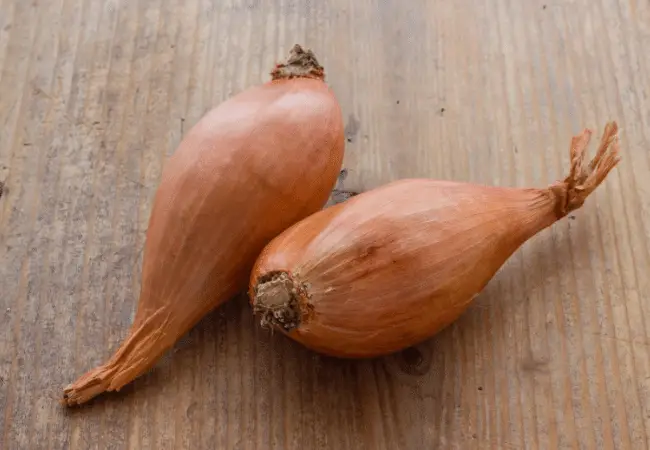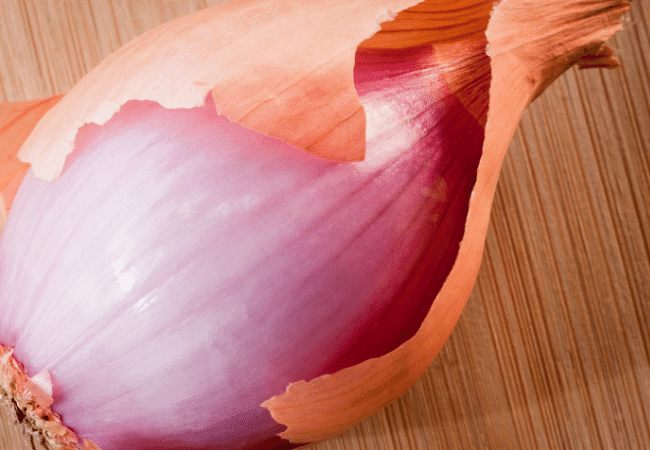It’s easy to confuse scallions and shallots, especially for new gardeners and cooks. I remember going to the grocery store as a much younger adult and having a battle in my head whether my wife said to pick up scallions or shallots. They both started with “s”, they both had “ll”, and both were in the onion section. Ugh, who’s the wise guy(s) that named these two? I think I ended up buying both and dealt with explaining to my wife the whole ordeal.
As my cooking and gardening expertise has greatly improved over the years, I have learned the many differences and similarities between shallots vs scallions. After reading this article, I am confident you will be able to distinguish between these two vegetables.
Table of Contents
What are Shallots?
Shallots are associated with the allium family. There are literally hundreds of species within this family. The most popular are onions, chives, and garlic.
Shallots are primarily used in cooking for their edible bulb (pictured below). The outside brown papery layer is peeled off to reveal an interior similar to a small onion. This interior is what is sliced or diced to be used as an ingredient in such things as sauces, stews, dressings, and salads.
The picture directly below is what shallots look like in the store. They are typical much smaller than an onion with a size closer to a garlic bulb. They can often be found sold in a bag or plastic container with multiple shallots in each package. Additionally, they can be found sold individually and priced based on the weight or per shallot.

The below picture on the left shows a shallot partially peeled open to show the onion-like interior that is variations of purple in color. The picture on the right reflects a shallot cut open. Notably the shallot has cloves similar to garlic that can be separated if desired.
What are Scallions?
Similar to shallots, scallions are in the allium family. They are young onions that do not have bulbs and grow in bunches.
They have a long, tubular structure. Moving up from the root, the color changes from white to light green, to a darker green. The green stalks are hollow and the white base has roots.
The whole portion of the scallion is edible from the white portion all the way up to the dark green area. However, most people discard the roots and damaged/discolored leaves.
Scallions are used in numerous dishes such as fried rice, stir-fry, dips, salads, baked potatos, and much more. They are commonly sliced thin at maybe 1/8 inch to add as an ingredient. However, thicker cuts of scallions are also used for dishes like stir-fry that require high heat. The large cuts minimize burning of the scallions.
Here is how scallions will appear bunched in most stores.

Below are examples of how scallions might be chopped. The photo on the left shows a smaller chop that might be used for something like a salad versus the larger chop on the right that might be used for a dish like stir-fry.
Taste
While visual there is a clear difference in shallots vs scallions, what about their taste? In other words, do they both taste the same or is there a distinct difference between the two?
Shallots have a mild onion flavor with a bit of sweetness. The sweetness becomes more pronounced when cooked. Their flavor does not overpower the palate, therefore, they can be consumed raw in small portions. Shallots also have a slight garlic flavor to them.
Scallions are also mild in flavor and can be eaten raw in meals like salads. The white portion has a stronger onion flavor than the milder green areas. When scallions are heated, they take on a sweeter flavor. Unlike shallots, scallions do not have a hint of garlic flavor. They are much more like an onion than a garlic clove
Nutrition
Based on the nutrition facts of shallots vs scallions, scallions have a bit less calories and carbohydrates compared to shallots. Additionally, scallions have more beneficial Vitamins A & C compared to shallots. That being said, most people don’t opt for scallions over shallots simply for their nutrition. They will select shallots or scallions based on their taste preferences or how they fit into a recipe.
| Shallots (Raw) | Scallions (Raw) | |
| Serving Size | 100g | 100g |
| Calories | 72 | 32 |
| Total Fat | 0.1g | 0.1916.8 |
| Carbohydrate | 16.8g | 7.34g |
| Dietary Fiber | 3.2g | 2.6g |
| Sodium | 12mg | 2mg |
| Cholesterol | 0mg | 0mg |
| Sugars | 8g | 2.3g |
| Protein | 2.5g | 1.83g |
| Vitamin A | 0% | 19% |
| Vitamin C | 13% | 31% |
| Calcium | 3% | 7% |
| Iron | 6% | 8% |
| Vitamin D | 0% | 0% |
| Vitamin B-6 | 15% | 5% |
| Magnesium | 5% | 5% |
Growing Shallots and Scallions
Shallots should be planted in full sun. They are able to grow in planting zones 4-10. You can verify your zone here if you are unsure of it. The date to maturity is approximately 90 to 110 days. They can be planted in late fall, spring, or early summer depending on when you want to harvest. You can grow shallots from sets or bulbs at about 5 inches apart and in shallow dirt. They can tolerate soil with a pH of about 6 to 7 so be prepared to adjust the pH (i.e. add lime to make it less acidic) if your soil falls out of this range.
The below video provides a nice overview on how simple it is to plant shallots.
Scallions are extremely economically because you can grow them from grocery store scallions. They grow rapidly and are extremely hardy. You simple bury the white portion of the scallions that have roots and leave any green portion that remains above the soil surface. Plant each scallion about 4 to 6 inches apart.
The below video via Greg the Gardener provides an excellent tutorial on how to grow scallions from store bought scallions. Some decent garden soil, basic garden tools, and a bit of water is all that you need to get scallions growing.
Can You Substitute Shallots for Scallions or Scallions for Shallots?
Yes, shallots and scallions can typically be swapped for each other in recipes if they are being cooked. This is especially true if they are being hidden amongst several ingredients.
However, if a recipe calls for a raw shallots or scallions, a substitute of one for the other is just too far off in flavor to work. You should make the dreadful trip to the grocery store for missing shallots or scallions instead of trying to substitute them.






